I drove from my Bay Area home last week to attend the memorial service for much-loved fencing master Delmar Calvert. He passed away a few months ago at the venerable age of 94 years, well loved, well cared for, and visited frequently by friends and former students until the end.
It was my fortune to get a chance to meet some of his students from his years teaching in the Portland area. Since I knew him during his Bay Area time at both UCSC and The Fencing Center, I wasn’t aware of the amount of teaching he did after “retiring” in 1991 from Santa Cruz and moving North. Apparently, he got very antsy after learning that retirement didn’t afford him the chance to teach, so he jumped back in, working mostly at Salle Trois Armes. If the people I met at the memorial were any indication, just as he did in Los Angeles and Central Cal, Delmar surrounded himself with excellent people who appreciated being in the presence of such an honorable human.
Delmar Calvert and his crew of Banana Slugs from UC Santa Cruz. They appear to have made off with some hardware.
His friend and, later, caretaker Corrie Cloo-Klein put together the memorial service and made sure everyone was at ease and had the opportunity to share their thoughts and remembrances of Delmar. Corrie also put aside some photographs and documents for me to scan for The Archive. While I was visiting her and scanning away, she continued to find, in little piles here and there throughout the apartment she shared with Delmar in his last days, some incredible treasures that serve as guideposts for me in tracking the course of this amazing individual’s life.
Delmar is on the right standing with his older brother, shortly after beginning their enlistment in the French Foreign Legion. He told me once that he and his brother were motivated to enlist after seeing Gary Cooper in “Beau Geste”, which came out in 1939. Doing the math, since he was born in July of 1924 and this film probably didn’t make it to Algeria until the Fall of ’39, he must have enlisted as a Legionnaire at the age of 15. Looking at this photo, he looks much older than his older brother.
One of the best documents for gathering the basics is a resume Delmar revised sometime after he got to Oregon, as it lists under present employment, “Since March 1991, retired”. Which we know didn’t last. However, it also lists every school he taught at, every International team he coached, his employment record and his scholastic achievements. Not to mention, awards he won (Bronze Star, Croix de Guerre), his military status and areas of teaching specialization. The only mystery to me is that he doesn’t list what he did with his time from demobilizing from the US Army through 1955. His first listed job starts in 1956 as a Vocational Counselor at the Cook County Welfare Department in Chicago, IL. In the interview I did with him five years ago during one of Portland’s famed Snowpocalypse adventures, he told me his first job after the Army was assisting at Ralph Faulkner’s Falcon Studios. So sometime in the ten-ish years prior to 1956, he taught for Faulkner, and attended three schools in Chicago: Wilson Jr. College, DePaul University and Sherwood Music College, coming out with a Bachelor of Music degree, a Teachers Diploma and a Teaching Accreditation. That all goes along with his Fencing Master degree in three weapons from the French Army (Joinville methodology, which is to say, the French Military system of training fencing master, including Hungarian sabre) that he earned in Fez, Morocco.
Delmar with his Legion unit. He’s the one with the “X” over his head.
Alas, this is a scan of what looked like a xerox copy of this photograph. Low quality or not, I had to put this one in. Delmar on the left, training in the salle d’armes in Fez, Morocco. This outpost of French Military Fencing Master training adhered to the curriculum developed over decades at the main military gymnastics and fencing school at Joinville-le-Pont. Delmar spoke of the fat old masters who would crush out their cigarettes before putting the young trainees in their place with all three weapons. Three years at this school left you with the ability to train all three weapons with either hand. What’s that? You’d like to know what manner of facility the French had at their disposal that they might endure their time training in the desert? Here are the architectural plans for the “Cercle Royal d’Escrime et Jardin Suspendu”, Fez, Morocco. That translates to “Royal Fencing Circle and Hanging Gardens”. (You can download them.) So, I guess it could have been worse. The plans are all in Arabic, in case anyone out there cares to translate the good parts. It’s all rather grand.
In an earlier story about my visit with Delmar I’ve told about how he and some Spanish Legionnaires who, like Delmar, had no interest in fighting for Vichy France against American forces, surrendered to the US Army. After making that move, Delmar immediately enlisted in the US Army and was put to use as a translator. Having spent many growing up years in Algeria he was competent in French, English, Italian and Arabic – a useful skillset. In charge of a squad of commandos during the capture of Sicily, he became acquainted with George Patton, helped liberate Palermo and a third of the island in five days, then trained as a paratrooper in preparation for dropping in behind German lines into the Vercors region of France just after D-Day to train and fight with the Macquis du Vercors French resistance. He could drive any vehicle, use any number of weapons from guns to artillery and was specifically noted to be trained in “unarmed and hand weapons” combat. He told the story that Patton once found him a comfy place to sleep and upon returning to his commando unit was queried about his night’s whereabouts. Delmar answered, “Hey, we’re commandos. We don’t talk about where we’ve been or what we’ve been doing.”
His photo from his American identification which were printed with the notice that if you lost your ID papers, they would not be replaced. I’d imagine that was important to remember.
After his time in the Army, teaching for Faulkner and completing his education, he started Salle Calvert in the Chicago area and taught there, in addition to his day job, from 1956 until 1962. He had some teams that threatened at Nationals during this time but failed to medal. He did place one fencer on the Pan American Games team in Chicago in 1959, Larry Silverman. He was a consistent semi-finalist at Nationals in foil and sabre and in 1959 made the men’s foil finals, qualifying him for a spot on the team.
Delmar with his Salle Calvert students. Larry Silverman is next to Delmar. The other fencers are unknown.
Autographed “To my coach Delmar, Larry Silverman”. Larry was a long-time administrator in the midwest in addition to being a tough bout in two weapons.
In 1962, Delmar relocated once again to the West Coast, taking up the mantle as head coach at the Los Angeles Athletic Club, a position he would hold for twenty years. In addition to this gig, he also taught, at various times, at Cal State LA, Cal Tech, Pasadena City College, Los Angeles City College and USC. Many of those sort of came and went over the years, but the Cal State LA job lasted the same twenty years as his time at the LAAC.
I can’t solve the fuzzy quality of this photo, unfortunately. Maybe someone can put some names to one or two of these folks even in their out of focus state.
Heizaburo Okawa and Delmar Calvert after a workout at the LAAC. The photo at the very top of today’s article is also of these two from a strobe light equipped photo shoot. Both of these men were French trained, which I’m guessing made them a pretty good team.
Delmar congratulates the finalists at the 1968 Men’s Foil Nationals. This was Okawa’s second first place finish in a row. From left, Jeff Checkes, Heizaburo, Herb Cohen, Albie Axelrod.
Also at the LAAC, Delmar had a great run with his junior fencers and created numerous junior champions. Above top, Bradley Thomas, Sue Foote and Joy Ellingson. Interestingly, growing up in Pomona, CA, I recall seeing Joy and Sue on a local LA news channel broadcast when I was 15. It was the first time I ever saw what fencing looked like. They were shown fencing at a local tournament and talking about getting ready for Junior Nationals. I think they might have interviewed Delmar as well, but I only noticed Joy and Sue while thinking, “this looks like my kind of sport!” I was 15. A few years later, Joy and I were housemates near San Jose State along with a couple of other fencers.
It’s my understanding that 1982 was a watershed moment, when the LAAC decide after about eight decades to drop fencing as an offering for members. Just in time, Delmar received notice that UC Santa Cruz was in the process of accepting applications for a fencing coach to replace Charlie Selberg. Charlie had built up a busy program at UCSC. Lots of classes, beginning up through the competitive crowd, and the school wished to continue on that course. A group of administrators, students and an outside fencing master (John McDougall) convened to review resumes. They cut the list of potential candidates to five, then gathered to have each one of the five teach a group class and give an individual lesson. Delmar was the last to give the individual lesson. You may have noticed I mentioned earlier that Delmar was trained to teach all three weapons with both hands? Well, as the icing on the cake for his application, he got a right handed fencer and a left handed fencer and gave a two handed individual lesson with both fencers – at the same time. I’ve seen him perform this trick and it’s very impressive. According to John, after seeing the dual lesson, the UCSC board really didn’t need much decision making time.
Goofing at the beach, 1957.
Delmar Calvert was a wonderful teacher, generous with this time and effort and a surrogate father figure to many. He taught from 1956 until he could physically no longer do it and passed away in April of this year. He will be missed and he will be remembered. Many upon many people were impacted by his unselfish effort, young and old. If you never had a chance to meet him, don’t miss an opportunity to ask those who had the privilege to train with him to tell you a story. The memory of the man will be around a long time.

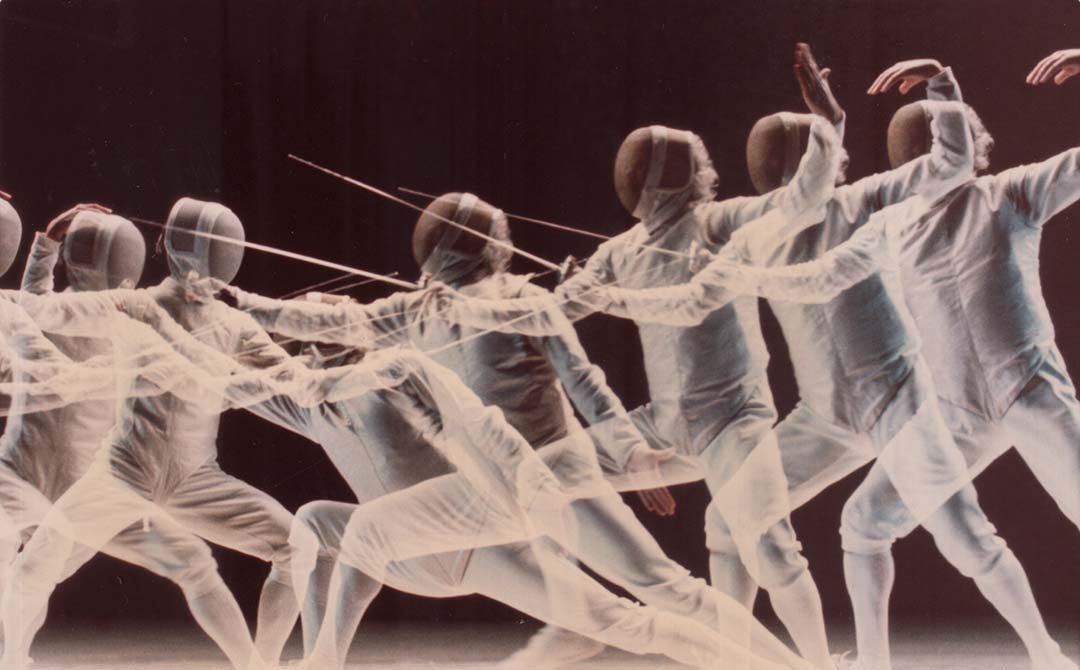
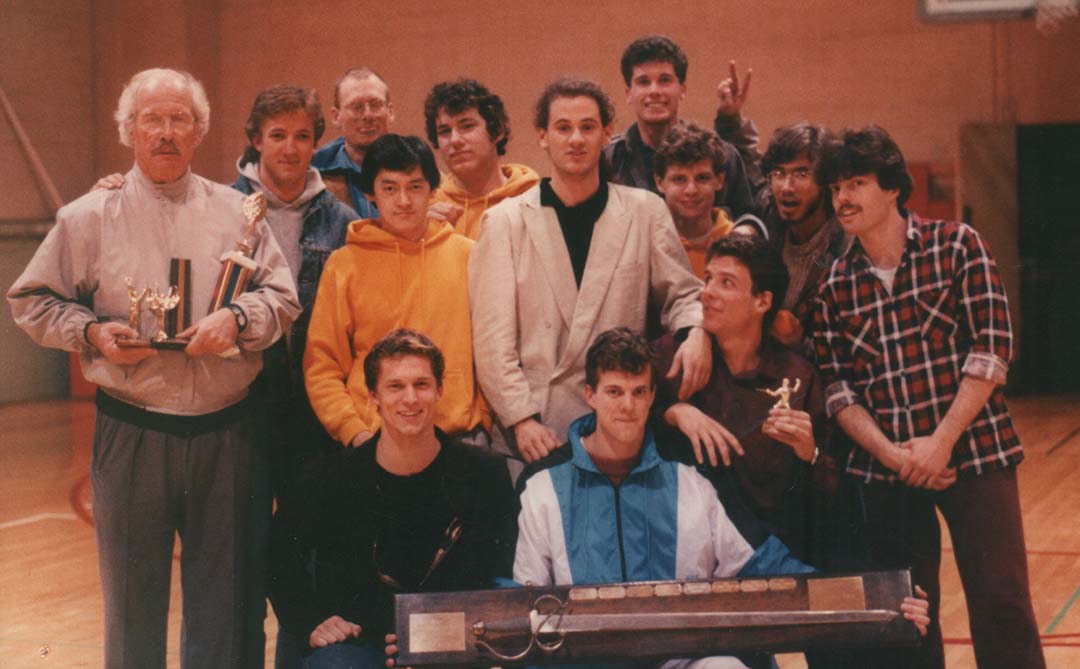
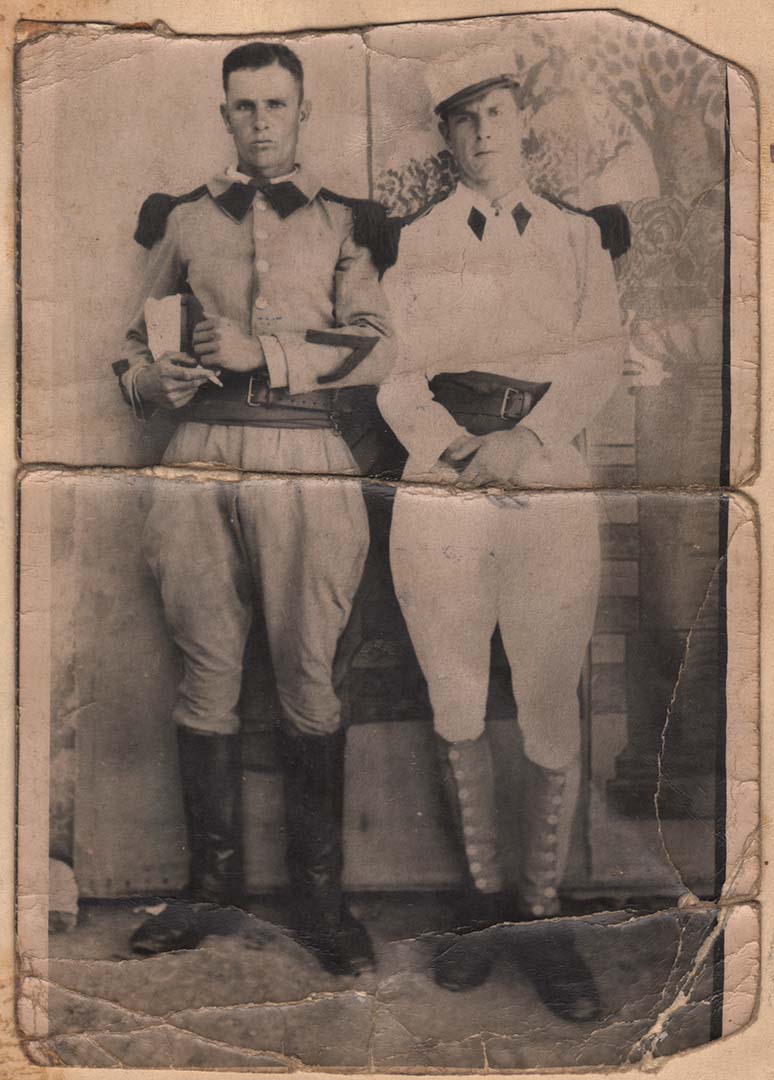
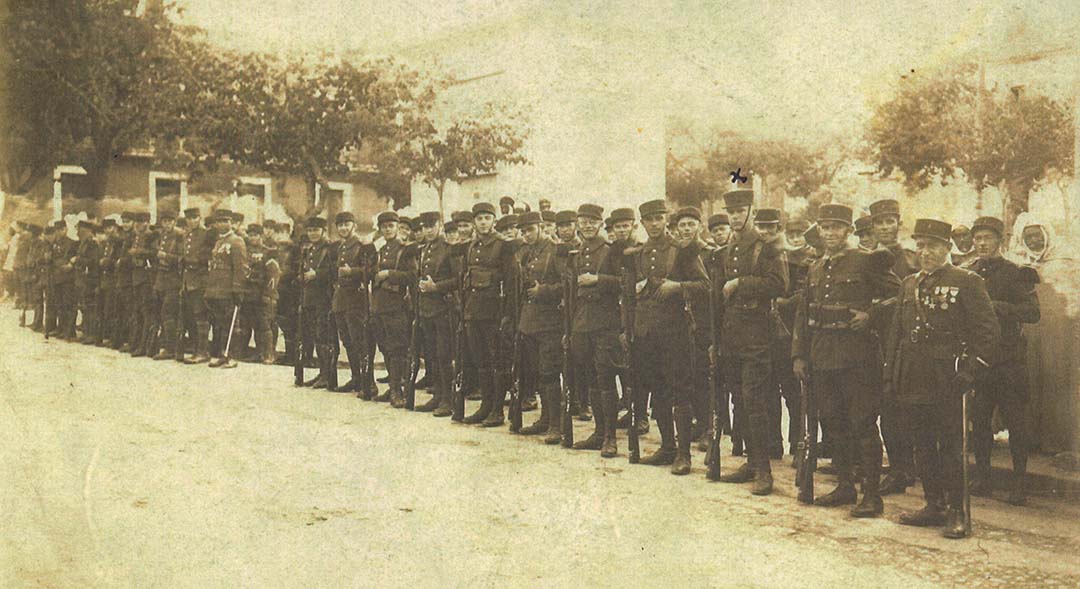
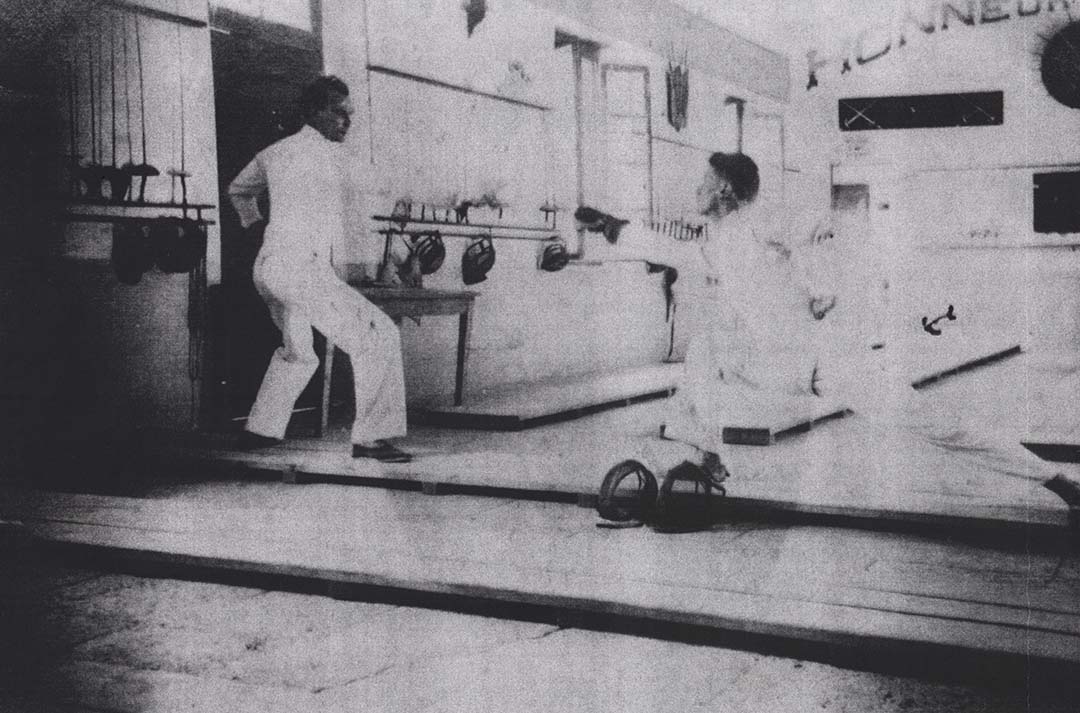
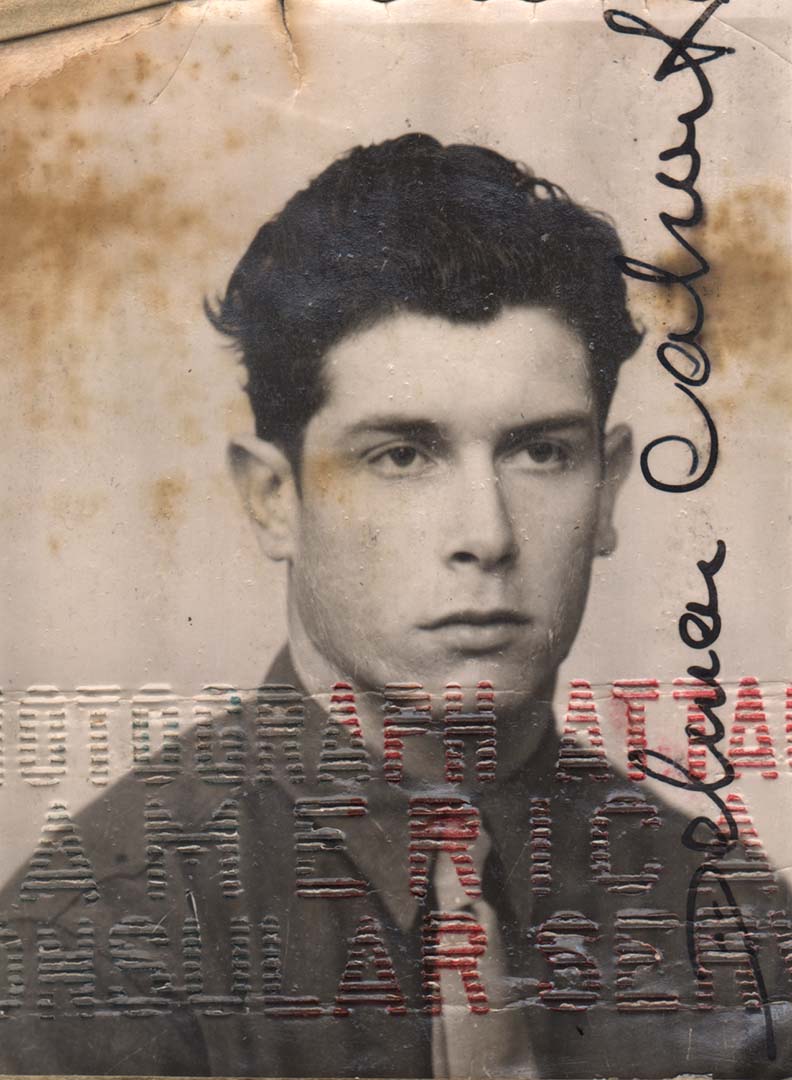
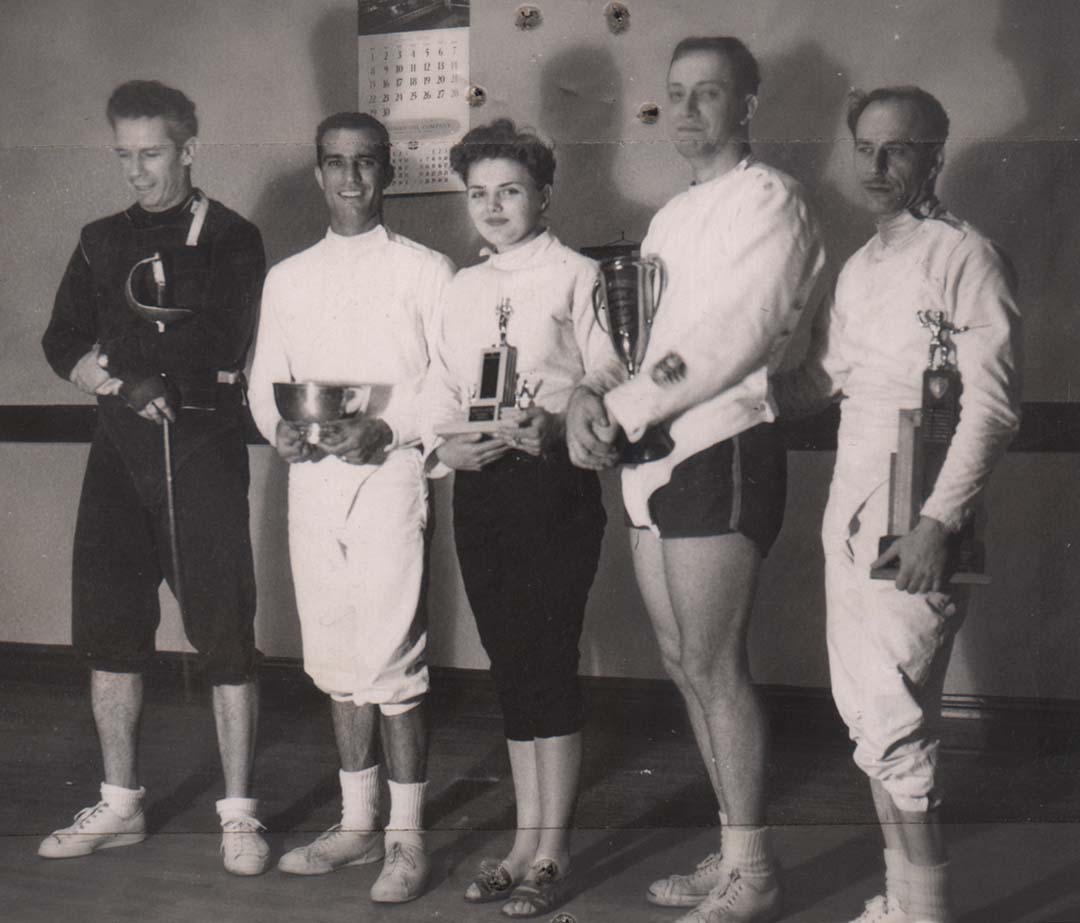
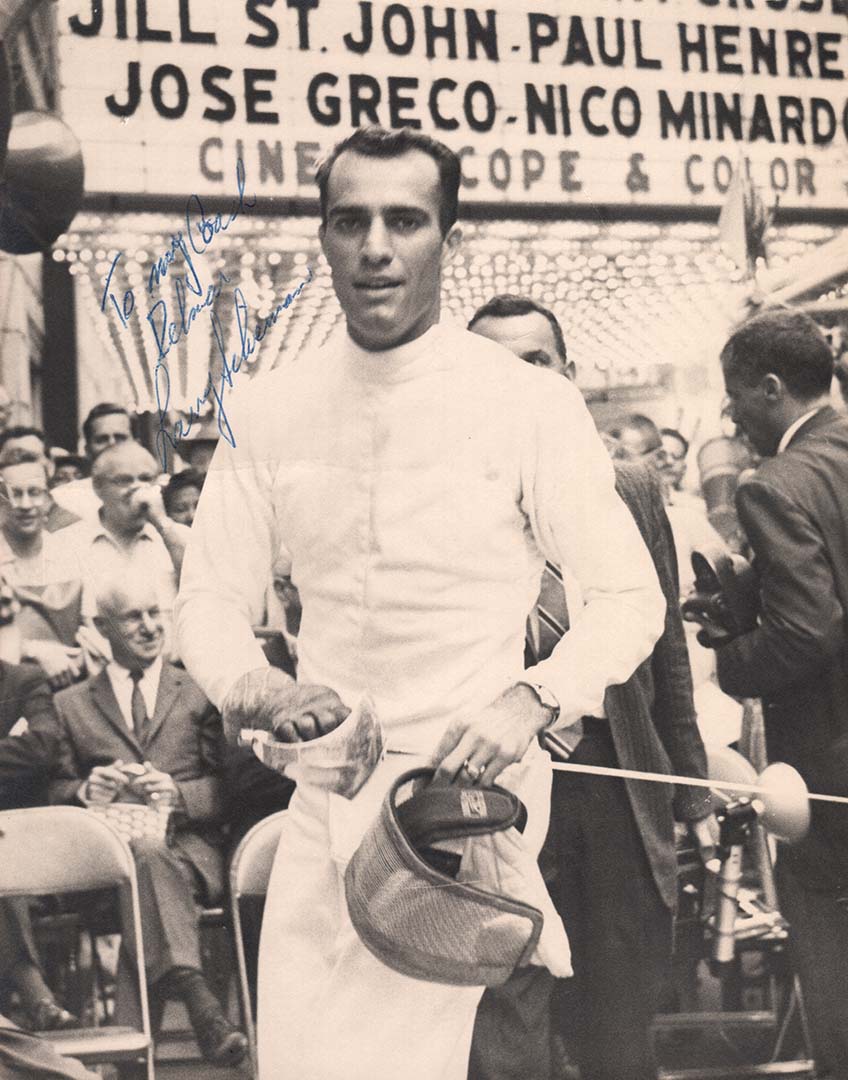
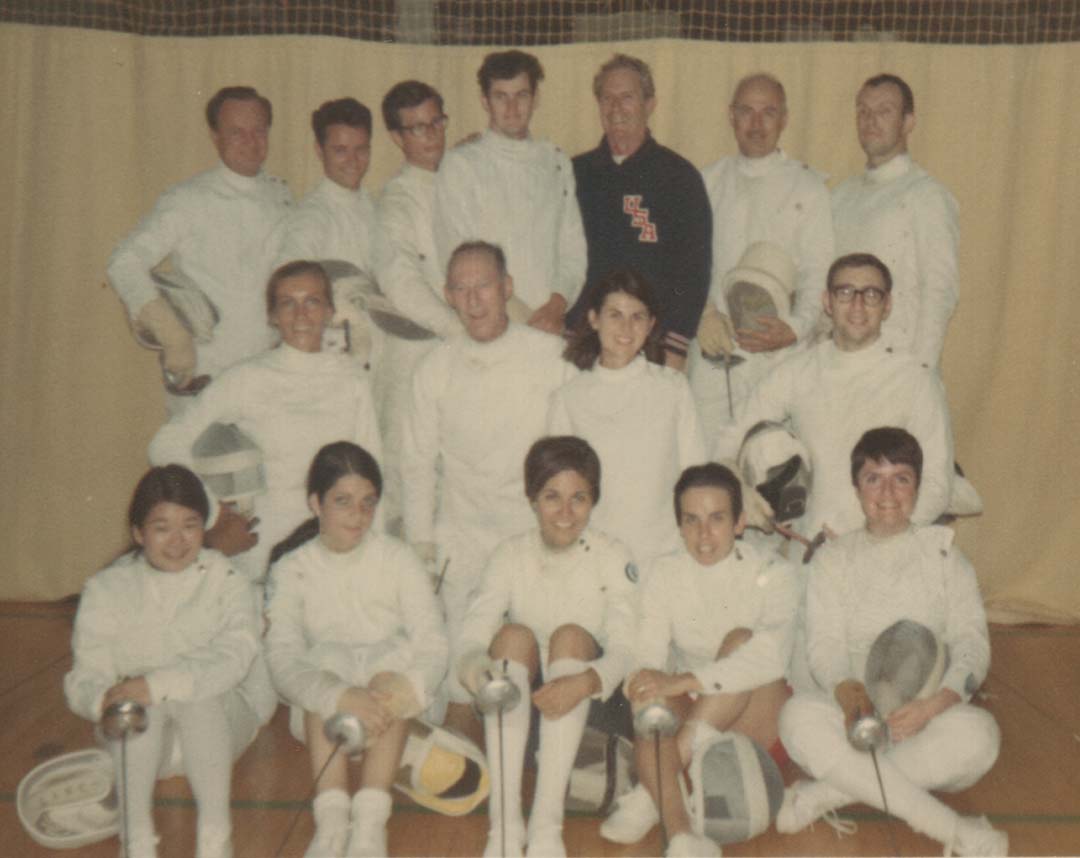
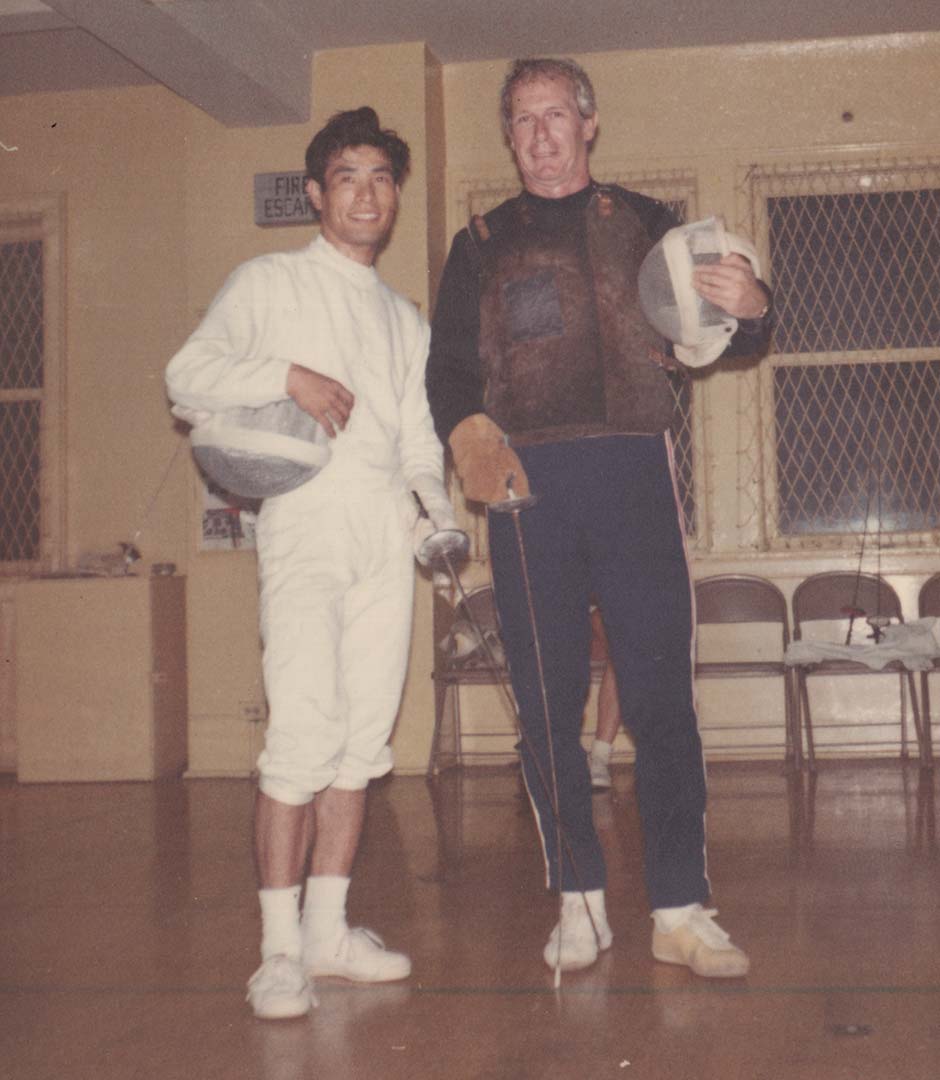
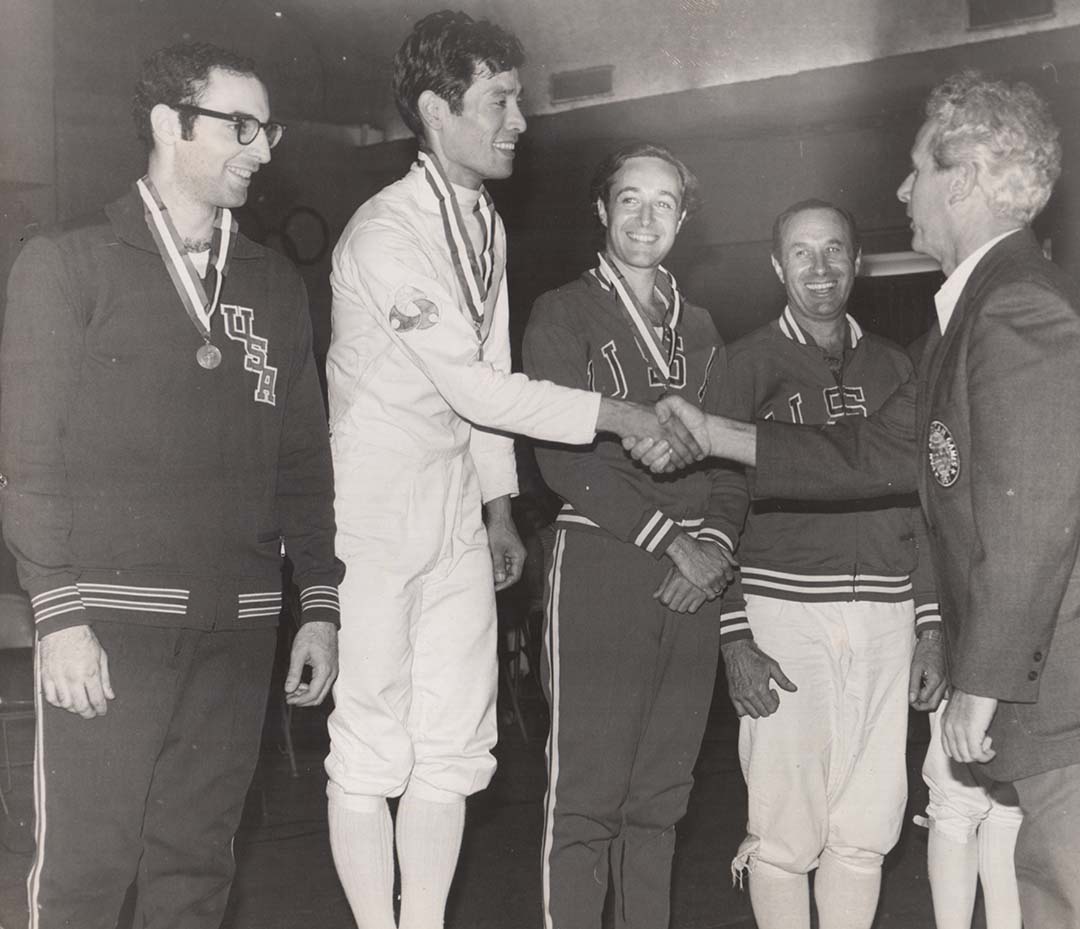
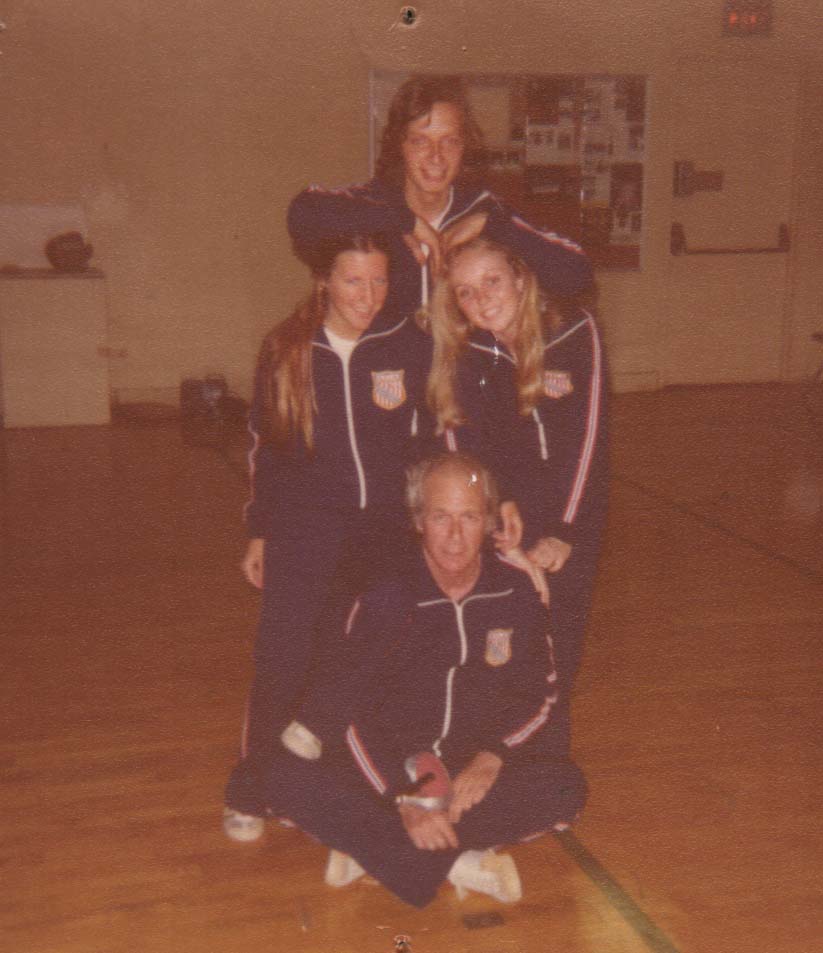
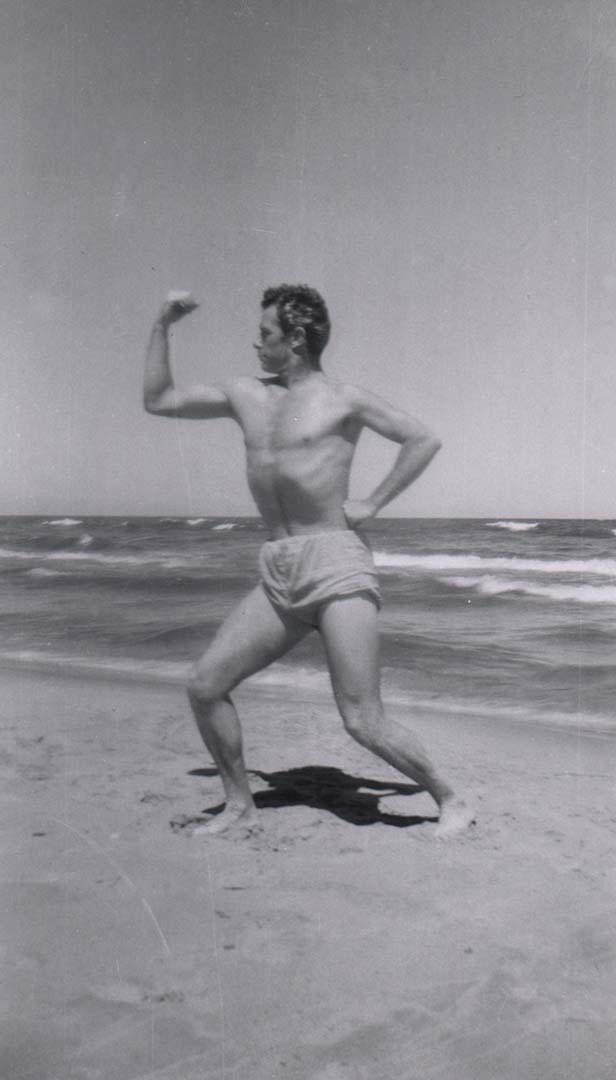
Doug, it was an honor to meet with you and discuss Maitre Calvert’s legacy here in Portland, and, in California. This is a beautiful tribute!
Jim Tschen Emmons
I benefited from a few of his double lessons early in my training (in his STA days). When paired with a more advanced student it was a fantastic way for the beginner to pick up the proper tempos–really eye-opening. It was also excellent at enforcing clean tight actions since sloppiness would get you out of your ‘lane’. A really cool experience–of course at the time I had no idea how rare they are or how lucky I was.
Great article about Delmar, on a scale of 1 to 10 he was a 12. He was a very colorful guy with a great sense of humor. He was not only a great fencing coach, but a terrific person and a joy to be on a team with. I lived in SoCal most my life and saw Delmar often at local competitions. I have seen the two handed lessons you mentioned multiple times and his normal competitive lessons to his students who I competed against often. They were all good fencers, Delmar produced some of the elite West Coast fencers during my generation.
I am honored to have been his friend and cherish the memories of the teams we were on.
I had the good fortune to be on the foil team at UCSC from 1987-89, and I will never forget what an amazing teacher and person Coach Calvert was. He more than lived up to his life story, and I am grateful for the brief time I knew him.
Does anyone here recall Les Bleumaster sp? who had a club in Fullerton in
the early seventies and then was at Cal State Fullerton before Okawa?
I’ve been meaning to do a story on Les Bleamaster for some time now. I’m hoping to get back to regular posts soon and his story is an important one to tell!
Les Bleamaster is still alive in San Antonio, Texas. His fencing studio was Salle De Escrime. And my sister and I started with Les, before we moved to the LAAC following Les’ move to the middle east for a few years. Often times, we took dual lessons from Delmar….I think we thought it was “normal” but later on realized how rare an ability it was.
I realize this comment is a couple years late, but I’m reconnecting with fencing again during the Olympics (as I do every 4 years). I was a student of Delmar at UCSC 88-91. Unfortunately, at that time, there was only women’s foil that was competitive, and as my weapon of choice was saber, I couldn’t compete, but I enjoyed working out with the team and at Salle Santa Cruz. Watching saber at the Olympics now and comparing it to what I learned, and then seeing some of the pictures in this article, the sport has evolved a lot. What I remember was the signature, explosive “wo-pah!!!” move where you just exploded off the back leg after testing the opponent a few times. Of course, as a leftie, I had a bit of an advantage!
It’s never too late to talk about Delmar Calvert. He was one of a kind. And I have zero trouble picturing exactly what you mean by “wo-pah!” Thanks for your comment!
I knew Maitre Calvert very well, as he was my husband’s fencing coach in Chicago, and also a friend. Larry Silverman was also a great friend of ours.
To put one more name to the photo of Delmar Calvert with Larry Silverman: the fencer on the far right is Nat Shapiro (my husband), who was one of the star fencers of Calvert’ club. He acquired several gold and silver medals in competitions in Illinois, Wisconsin, Ohio, etc. and in 1957 was classified 10th in the Nationals.